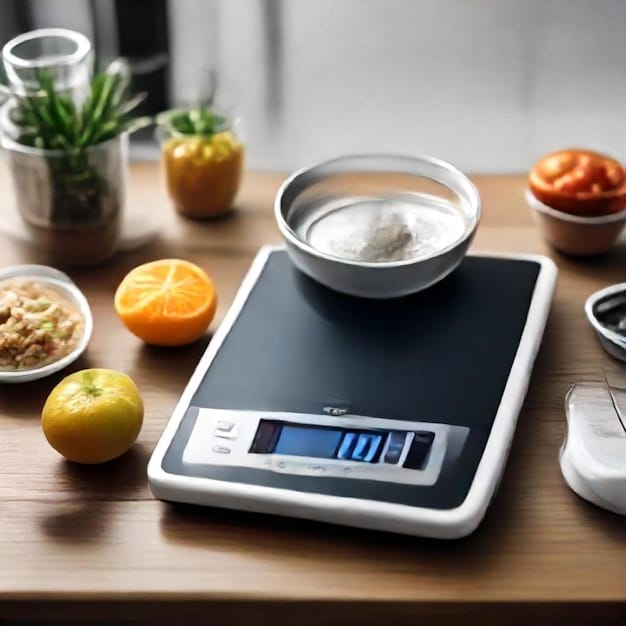The Ultimate Guide to Calorie Counting: Track Your Macros and Achieve Your Goals

The Ultimate Guide to Calorie Counting: Track Your Macros and Achieve Your Goals involves tracking your daily calorie intake to manage weight and achieve specific fitness objectives. This guide breaks down the process into simple steps, ensuring you can effectively monitor your macros and reach your health goals.
Are you looking to take control of your diet and achieve your fitness goals? Understanding how to count calories and track your macros can be a game-changer. This comprehensive guide will walk you through everything you need to know, making **the ultimate guide to calorie counting: track your macros and achieve your goals** accessible and effective.
Understanding the Basics of Calorie Counting
Calorie counting might seem daunting at first, but it’s a fundamental tool for managing your weight and optimizing your nutrition. By understanding the basics, you can tailor your diet to meet your specific needs and goals.
What is a Calorie?
A calorie is a unit of energy that measures how much energy you get from a food. Your body uses these calories to fuel everything from breathing to running a marathon. Understanding this basic principle is essential for the ultimate guide to calorie counting: track your macros and achieve your goals.
Why Count Calories?
Counting calories helps you stay aware of your energy intake. This awareness is crucial for:
- Weight Loss: Consuming fewer calories than you burn leads to weight loss.
- Weight Gain: Eating more calories than you burn helps you gain weight, often for muscle building.
- Maintenance: Consuming the same number of calories you burn helps maintain your current weight.
Ultimately, **the ultimate guide to calorie counting: track your macros and achieve your goals** provides a structured approach to managing your energy balance.
Common Misconceptions About Calories
There are several myths about calories that can confuse people. It’s important to separate fact from fiction:
- Not all calories are created equal: While a calorie is a calorie in terms of energy, the nutritional value of the food source matters. 100 calories from broccoli is better than 100 calories from a donut.
- Starving yourself is not effective: Severely restricting calories can lead to muscle loss and a slower metabolism. **The ultimate guide to calorie counting: track your macros and achieve your goals** emphasizes balance.
- You can’t eat whatever you want as long as it fits your macros: While tracking macros is important, focusing on whole, unprocessed foods is key for overall health.
Understanding these basics will set you up for success when using **the ultimate guide to calorie counting: track your macros and achieve your goals**. Getting started right is half the battle.
Calculating Your Daily Calorie Needs
Before you dive into calorie counting, you need to determine your daily calorie needs. Several factors influence this, including your age, gender, activity level, and goals.
Basal Metabolic Rate (BMR)
Your BMR is the number of calories your body needs at rest to perform basic functions like breathing and circulation. The Harris-Benedict equation is a common method to estimate BMR:
For men: BMR = 88.362 + (13.397 x weight in kg) + (4.799 x height in cm) – (5.677 x age in years)
For women: BMR = 447.593 + (9.247 x weight in kg) + (3.098 x height in cm) – (4.330 x age in years)
Understanding your BMR is the foundation for **the ultimate guide to calorie counting: track your macros and achieve your goals**.
Activity Level Multiplier
Once you have your BMR, you need to adjust for your activity level:
- Sedentary: BMR x 1.2 (little to no exercise)
- Lightly Active: BMR x 1.375 (light exercise/sports 1-3 days a week)
- Moderately Active: BMR x 1.55 (moderate exercise/sports 3-5 days a week)
- Very Active: BMR x 1.725 (hard exercise/sports 6-7 days a week)
- Extra Active: BMR x 1.9 (very hard exercise/sports & physical job)
Multiplying your BMR by the appropriate activity level gives you your Total Daily Energy Expenditure (TDEE), which is the number of calories you burn each day.
Adjusting for Your Goals
To either lose, maintain, or gain weight, you’ll need to adjust your TDEE:
- Weight Loss: Subtract 500 calories per day to lose about 1 pound per week.
- Weight Gain: Add 250-500 calories per day to gain weight gradually.
- Maintenance: Keep your calorie intake at your TDEE.
**The ultimate guide to calorie counting: track your macros and achieve your goals** also involves understanding how these adjustments impact your overall fitness journey.
Tracking Your Macros: A Step-by-Step Guide
While calorie counting is important, tracking your macros—protein, carbohydrates, and fats—can optimize your results. Macros affect your body differently, influencing muscle growth, energy levels, and overall health.
Understanding Macronutrients
Each macronutrient plays a unique role in your body:
- Protein: Essential for muscle repair and growth, hormone production, and immune function.
- Carbohydrates: The body’s primary source of energy, fueling physical activity and brain function.
- Fats: Important for hormone production, nutrient absorption, and overall health.
**The ultimate guide to calorie counting: track your macros and achieve your goals** emphasizes the importance of balancing these macronutrients for optimal performance.
Determining Your Macro Ratios
The ideal macro ratio depends on your goals and activity level:
- For Weight Loss: A common ratio is 40% protein, 30% carbs, and 30% fat.
- For Muscle Gain: A popular ratio is 30% protein, 40% carbs, and 30% fat.
- For General Health: A balanced ratio is 30% protein, 35% carbs, and 35% fat.
Adjust these percentages based on how your body responds and your dietary preferences.
Using Calorie Tracking Apps
Apps can simplify the process of tracking both calories and macros. Popular options include:
- MyFitnessPal: A comprehensive app with a vast food database and macro tracking features.
- Lose It!: Another popular option with a user-friendly interface and social support features.
- Cronometer: Known for its accuracy in tracking micronutrients as well as macros.
These apps make **the ultimate guide to calorie counting: track your macros and achieve your goals** more manageable and efficient.

Practical Tips for Effective Calorie Counting
Calorie counting is not just about numbers; it’s about understanding your eating habits and making informed food choices. Here are some practical tips to make the process more effective and sustainable.
Read Food Labels Carefully
Always read food labels to understand the serving size, calorie count, and macro breakdown. Pay attention to hidden sugars and unhealthy fats.
Measure Your Portions
Use measuring cups and a food scale to accurately measure your portions. Eyeballing can lead to overestimation or underestimation of calories.
Plan Your Meals in Advance
Planning your meals ahead of time can help you stay on track and avoid impulsive, high-calorie choices. It’s a core component of **the ultimate guide to calorie counting: track your macros and achieve your goals**.
Be Consistent
Consistency is key to seeing results. Track your calories and macros every day, even on weekends. The more diligent you are, the better you’ll understand your eating patterns.
Overcoming Common Challenges in Calorie Counting
Calorie counting comes with its share of challenges. However, with the right mindset and strategies, you can overcome these hurdles and achieve your desired results.
Dealing with Social Situations
Eating out or attending social events can make calorie counting difficult. Here’s how to manage these situations:
- Plan Ahead: Look at the menu online and choose a healthy option in advance.
- Make Smart Swaps: Opt for grilled or baked dishes instead of fried foods.
- Control Portions: Ask for half portions or share a meal with a friend.
**The ultimate guide to calorie counting: track your macros and achieve your goals** should adapt to your lifestyle, not restrict it.
Avoiding Obsession
It’s important to avoid becoming overly obsessed with calorie counting. Focus on overall healthy eating habits and listen to your body’s cues.
Staying Motivated
Keep your goals in mind and celebrate small victories along the way. Join a support group or find a workout buddy to stay motivated.
Adjusting as Needed
Your calorie and macro needs may change over time, depending on your activity level, weight, and goals. Be prepared to adjust your plan accordingly. Remember that **the ultimate guide to calorie counting: track your macros and achieve your goals** is a flexible tool.

Long-Term Sustainability of Calorie Counting
For calorie counting to be effective in the long run, it needs to be sustainable and integrated into your lifestyle. This involves making mindful food choices, understanding your body’s needs, and avoiding restrictive diets.
Focus on Whole Foods
Prioritize whole, unprocessed foods like fruits, vegetables, lean proteins, and whole grains. These foods are nutrient-dense and will keep you feeling full and satisfied.
Mindful Eating
Pay attention to your body’s hunger and fullness cues. Eat slowly and savor each bite. Avoid distractions like TV or your phone while eating.
Finding Balance
Allow yourself occasional treats without guilt. A balanced approach to eating is more sustainable than strict dieting. The journey toward **the ultimate guide to calorie counting: track your macros and achieve your goals** is about finding what works for you.
By understanding the intricacies highlighted in **the ultimate guide to calorie counting: track your macros and achieve your goals**, you’re well-equipped to embark on a journey toward better health and fitness. Remember, **the ultimate guide to calorie counting: track your macros and achieve your goals** is a flexible tool that adapts to your individual needs and lifestyle.
| Key Point | Brief Description |
|---|---|
| 💪 Calorie Needs | Calculate your BMR and adjust for activity level and goals. |
| 🍎 Macro Tracking | Determine your macro ratios for protein, carbs, and fats based on your goals. |
| 📱 Tracking Apps | Use apps like MyFitnessPal or Cronometer to log your food intake. |
| 🎯 Meal Planning | Plan meals to stay on track and make healthier choices. |
Frequently Asked Questions
Calorie counting involves tracking daily calorie intake to manage weight. It’s important because it helps you understand your energy balance and adjust your diet accordingly. **The ultimate guide to calorie counting: track your macros and achieve your goals** can serve as a pathway to success.
Start by calculating your BMR using the Harris-Benedict equation. Then, multiply it by your activity level to get your TDEE. Subtract 500 calories from your TDEE to lose about 1 pound per week.
Macronutrients include protein, carbohydrates, and fats. To track them, use a calorie tracking app like MyFitnessPal, which allows you to log your food and see the macro breakdown for each meal. It’s a key component of **the ultimate guide to calorie counting: track your macros and achieve your goals**.
Common mistakes include inaccurate food logging, neglecting to measure portions, and not accounting for hidden calories in sauces and drinks. Being mindful and consistent can help avoid these pitfalls.
Focus on whole, unprocessed foods, practice mindful eating, and allow yourself occasional treats without guilt. Remember, **the ultimate guide to calorie counting: track your macros and achieve your goals** should complement a healthy lifestyle, not dictate it.
Conclusion
**The ultimate guide to calorie counting: track your macros and achieve your goals** provides a comprehensive understanding of how to manage your weight and optimize your nutrition. By implementing these strategies, you can achieve your fitness goals and maintain a healthy lifestyle.





